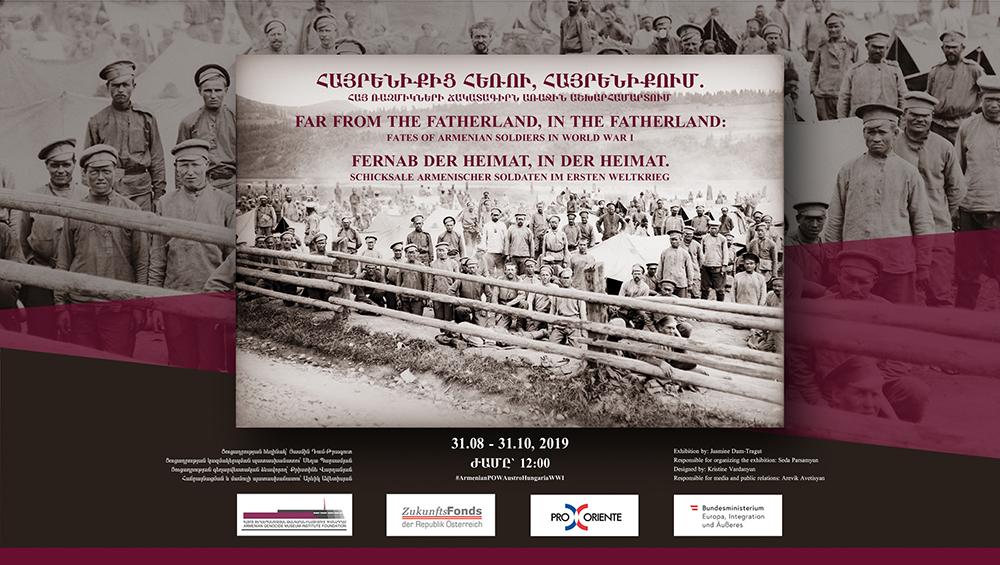
On 31 August, at the temporary exhibition hall of Armenian Genocide Museum-Institute Foundation a new exhibition and the presentation of the catalogue
“Far from the Fatherland, in the Fatherland: Fates of Armenian Soldiers in World War I” will take place.
Armenian Genocide Museum-Institute Foundation presents the research project of Assoc. Prof. Dr. Jasmine Dum-Tragut, Head of the Department of Armenian Studies at the Centre for the Study of the Christian East at the University of Salzburg, throughout a temporary exhibition and a catalogue dedicated to the describe the lives of Armenian soldiers in World War I. The experience of eastern Armenian soldiers fighting in the Russian army will be presented, their experiences far from home, on the front, when captured, their everyday experiences in enemy hands – in Austro-Hungarian captivity – their escape or liberation, their return to the fatherland and subsequent lives.
“Countless villages in Armenia were visited in search of traces of these prisoners of war, and the stories of the village elders, of relatives who were found, and even of the children of these Armenian prisoners were written down. Their fates explain how these Armenians had to leave their fatherland, then a part of the Tsarist Russian Empire, to serve the Russian Army in World War One, how they fought and how they fell into enemy hands and how they got back to their fatherland after escape or liberation and their future fate in the homeland. Stories that were written by those living in troubled times and which are as different as the individual prisoners. Far from the fatherland, in war and in captivity, they often experienced and saw unspeakable things, they suffered pain, homesickness and grief, but they could also experience humanity, respect and even enjoyment and learn new things”, mentions Jasmine Dum-Tragut.
The exhibition is equipped with unique archival photos, videos and exhibits, through which and through accompanying explanatory texts, an attempt is made to reveal the unusual life of the soldiers. 100 years old soldiers’ song and poems forms an important part of the exhibition. The voice record of Arshak Manukyan; a war prisoners is especially touching, which tells the following:
Armenian born in Lcen, lived in Yekaterinoslav, 30 years old, by profession confectioner, recites and sings the Armenian folk “The Armenian Crane”, Arshak labeled this song as “The bird of an unfortunate POW” 15.08.1915.
Being a prisoner of war, overcome the insurmountable, violence, starvation, illness, stress, death or home return, trying to integrate into society, whose attitude was unequivocal: many of the prisoners of war would still have to bear the label of a betrayer.
The exhibition is a unique platform to screen one of the heaviest consequences of any war. POW camps have been erected for about 1 million soldiers and 10,000 officers in Austria-Hungary. Of a total of 50 camps and stations, far less than the half were located in the territory of present-day Austria.
“This is a unique study in its nature, so the exhibition, too. The questions relate to the past and present of the Armenian people driven, not by their own volition, far from their fatherland in the hustle and bustle of World War One.
The lives of the Armenian prisoners of war in WW1 have not been studied at all.
Far from their fatherland, they lived in a state of longing for home. Their subsequent fates diverged. Most of them returned to that fatherland, either to their families or to found new families; some fell victim to Stalin; some lived peacefully; some kept their past a secret.
Jasmine, the researcher and Jasmine, the human have succeeded in uncovering the many stories of the former prisoners of war. With the help of her Armenian colleagues, she found the descendants of many prisoners of war and talked with them. Exchanging information, she rejoiced with them and was touched, saddened and wept with them”, mentioned AGMI Director Harutyun Marutyan.
In preparation for this exhibit, as much information as possible was collected from archives in Austria, Armenia and Russia, countless villages in Armenia were visited in search of traces of these prisoners of war, and the stories of the village elders, of relatives who were found, and even of the children of these Armenian prisoners were written down. Their narratives and memories, pictures from family albums, along with the historical documents from various archives, allow us to compose the life stories of these Armenian prisoners of war. Many families knew about their relatives’ time in captivity but for some this was completely new.
For more information and newsletters you can follow the following hashtag:
#ArmenianPOWAustriaHungaryWWI.
The opening ceremony will be in presence of descendants of war prisoners, guests, state officials, diplomats, academics, journalists and other guests from Armenia and Austria as well.
Exhibition by: Jasmine Dum-Tragut
Responsible for organizing the exhibition: Seda Parsamyan
Designed by: Kristine Vardanyan
Responsible for media and public relations: Arevik Avetisyan





